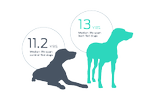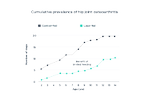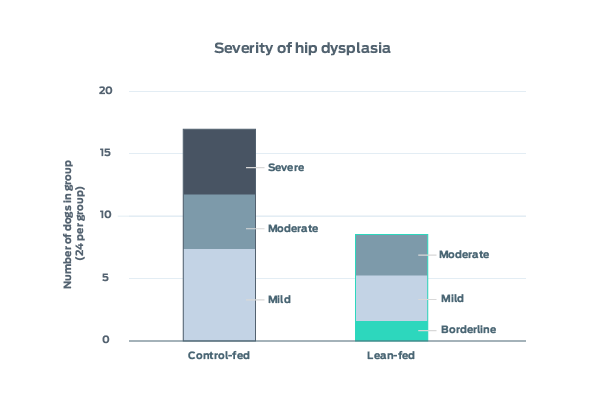

For decades, scientists have studied how dietary restriction, without malnutrition, can increase life span and delay the onset of multiple age-related diseases in some mammals.1-3
Purina research showed that maintaining optimal body condition from puppyhood and throughout life can improve both life span and health parameters in dogs.3-5
Purina's research


Graphic adapted from Kealy et al., 2002
In this landmark study, researchers monitored the health of 48 Labrador Retrievers throughout their lives during which half the dogs were fed 25% less (lean-fed) than their full-fed (control) siblings. The results showed that when dogs were fed to a lean body condition from puppyhood onward, lean-fed dogs lived better, for longer.
- Median life span was extended by 1.8 years or 15%. The mean lifespan for lean-fed dogs was 13 years compared to 11.2 years for control-fed dogs
- The 25% dietary restriction also delayed the onset of signs of chronic disease in these dogs 4
- Diet restriction had no adverse effects on skeletal maturation, structure or metabolism 4
Lean-fed puppies have healthier hips

By 2 years of age, the frequency of hip dysplasia in the lean-fed dogs was 50% less than in the control group, and was much less severe.
In this graph, the proportion of 12-year old dogs in the lean-fed group with OA was almost the same as that of control-fed dogs that were half that age.
By the end of the study, 83% of dogs fed the control diet had developed radiographic signs of hip OA compared to 50% of the lean-fed group.5

The prevalence and severity of OA in the shoulder and elbow joints was also lower in the lean-fed dogs. At 8 years of age, the prevalence of OA in two or more joint types was 77% among control-fed dogs, yet only 10% among lean-fed dogs.6

Lean dogs also experienced other health benefits:
- They showed greater insulin sensitivity, which is better for glucose regulation
- They were better able to maintain immune defense responses over time
- Age–related declines occurred later in life 4
Key things to remember
- A 14-year life span study in Labrador Retrievers showed that when fed to maintain a lean body condition from puppyhood, and throughout life, dogs live better, longer lives.
- The median life span of lean-fed Labrador Retrievers was extended an average of 1.8 years (15%).
- Maintaining optimal body condition throughout life can delay the onset, and reduce the severity, of osteoarthritis in dogs.
- Lean dogs also showed delayed onset of other chronic and age-related diseases.
Explore how nutrition can help pets lead better, longer lives:
Find out more
1. Fontana, L., Partridge, L., & Longo, V. D. (2010). Extending healthy life span--from yeast to humans. Science (New York, N.Y.), 328(5976), 321–326.
2. Kaeberlein, M., Creevy, K. E., & Promislow, D. E. (2016). The dog aging project: translational geroscience in companion animals. Mammalian genome: official journal of the International Mammalian Genome Society, 27(7-8), 279–288.
3. Kealy, R.D., Lawler, D.F., Ballam, J.M., Mantz, S.L., Biery, D.N., Greeley. E.H., & Stowe, H.D. (2002). Effects of diet restriction on life span and age-related changes in dogs. Journal of the American Veterinary Medical Association, 220, 1315-1320.
4. Lawler, D.F., Larson, B.T., Ballam, J.M., Smith, G.K., Biery, D.N., Evans, R.H., & Kealy, R.D. (2008). Diet restriction and ageing in the dog: major observations over two decades. British Journal of Nutrition, 99(4), 793-805.
6. Kealy, R.D., Lawler, D.F., Ballam, J.M., Lust, G., Biery, D.N., Smith, G.K., & Mantz, S.L. (2000). Evaluation of the effect of limited food consumption on radiographic evidence of osteoarthritis in dogs. Journal of the American Veterinary Medical Association, 217(11), 1678-1680.
Additional research related to this 14-year study:
6.1. Huck, J. L., Biery, D. N., Lawler, D.F., Gregor, T. P., Runge, J. J., Evans, R.H., Kealy, R.D., & Smith, G. K. (2009). A longitudinal study of the influence of lifetime food restriction on development of osteoarthritis in the canine elbow. Veterinary Surgery, 38(2), 192- 198.
6.2. Greeley, E. H., Kealy, R.D., Ballam, J. M., Lawler, D. F., & Segre, M. (1996). The influence of age on the canine immune system. Veterinary Immunology and Immunopathology, 55(1-3), 1-10.
6.3. Greeley, E.H., Ballam, J.M., Harrison, J.M., Kealy, R.D., Lawler, D.F., & Segre, M. (2001). The influence of age and gender on the immune system: a longitudinal study in Labrador Retriever dogs. Veterinary Immunology and Immunopathology, 82(1-2), 57-71.
6.4. Greeley, E.H., Spitznagel, E., Lawler, D.F., Kealy, R.D., & Segre, M. (2006). Modulation of canine immunosenescence by life-long caloric restriction. Veterinary Immunology and Immunopathology, 111(3-4), 287-299.
6.5. Kealy, R.D., Olsson, S.E., Monti, K.L., Lawler, D.F., Biery, D.N., Helms, R.W., Lust, G., & Smith, G.K. (1992). Effects of limited food consumption on the incidence of hip dysplasia in growing dogs. Journal of the American Veterinary Medical Association, 201(6), 857-863.
6.6. Kealy, R.D., Lawler, D.F., Ballam, J.M., Lust, G., Smith, G.K., Biery, D.N., & Olsson, S.E. (1997). Five-year longitudinal study on limited food consumption and development of osteoarthritis in coxofemoral joints of dogs. Journal of the American Veterinary Medical Association, 210(2), 222-225.
6.7. Larson, B. T., Lawler, D.F., Spitznagel, E. L., & Kealy, R.D. (2003). Improved glucose tolerance with lifetime diet restriction favorably affects disease and survival in dogs. Journal of Nutrition, 133(9), 2887-2892.
6.8. Lawler, D.F., Evans, R. H., Larson, B.T., Spitznagel, E. L., Ellersieck, M. R., & Kealy, R. D. (2005). Influence of lifetime food restriction on causes, time, and predictors of death in dogs. Journal of the American Veterinary Medical Association, 226(2), 225-231.
6.9. Lawler, D. F., Ballam, J. M., Meadows, R., Larson, B. T., Li, Q., Stowe, H. D., & Kealy, R. D. (2007). Influence of lifetime food restriction on physiological variables in Labrador retriever dogs. Experimental Gerontology, 42(3), 204-214.
6.10. Lawler, D. F., Larson, B. T., Ballam, J. M., Smith, G. K., Biery, D. N., Evans, R. H., & Kealy, R. D. (2007). Diet restriction and ageing in the dog: major observations over two decades. British Journal of Nutrition, 99(4), 793-805.
6.11. Richards, S. E., Wang, Y., Lawler, D., Kochhar, S., Holmes, E., Lindon, J. C., & Nicholson, J. K. (2008). Self-modeling curve resolution recovery of temporal metabolite signal modulation in NMR spectroscopic data sets: application to a life-long caloric restriction study in dogs. Analytic Chemistry Journal, 80(13), 4876-4885.
6.12. Richards, S. E., Wang, Y., Claus, S. P., Lawler, D., Kochhar, S., Holmes, E., & Nicholson, J. K. (2013). Metabolic phenotype modulation by caloric restriction in a lifelong dog study. Journal of Proteome Research, 12(7), 3117-3127.
6.13. Runge, J. J., Biery, D. N., Lawler, D. F., Gregor, T. P., Evans, R. H., Kealy, R. D., Szabo, S. D., & Smith, G. K. (2008). The effects of lifetime food restriction on the development of osteoarthritis in the canine shoulder. Veterinary Surgery, 37(1), 102-107.
6.14. Smith, G. K., Lawler, D. F., Biery, D. N., Powers, M. Y., Shofer, F., Gregor, T. P., & Kealy, R. D. (2012). Chronology of hip dysplasia development in a cohort of 48 Labrador retrievers followed for life. Veterinary Surgery, 41(1), 20-33.
6.15. Stowe, H. D., Lawler, D. F., & Kealy, R. D. (2006). Antioxidant status of pair-fed Labrador retrievers is affected by diet restriction and aging. Journal of Nutrition, 136(7), 1844-1848.
6.16. Szabo, S. D., Biery, D. N., Lawler, D. F., Shofer, F. S., Powers, M. Y., Kealy, R. D., & Smith, G. K. (2007). Evaluation of a circumferential femoral head osteophyte as an early indicator of osteoarthritis characteristic of canine hip dysplasia in dogs. Journal of the American Veterinary Medical Association, 231(6), 889-92.
6.17. Wang, Y., Lawler, D., Larson, B., Ramadan, Z., Kochhar, S., Holmes, E., & Nicholson, J. K. (2007). Metabonomic investigations of aging and caloric restriction in a life-long dog study. Journal of Proteome Research, 6(5), 1846-1854.


